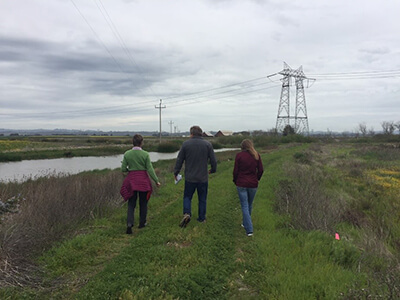Water Quality

Conservation Issue
Management of water quality in Monterey Bay National Marine Sanctuary (MBNMS) requires sophisticated planning, strategic implementation of best practices, comprehensive monitoring of conditions and management effectiveness, data integration, analysis, and reporting across a diverse group of institutions.
Description
Pollutants enter MBNMS from a variety of sources, including ocean transport from large adjacent urban areas, local urban runoff, and several large agricultural watersheds. MBNMS seeks to facilitate a cohesive approach for collection and analysis of data with the goal of determining the sources, loads, and effects of pollutants entering the sanctuary. Encouraging efforts to fill critical data gaps and making effective use of data from existing monitoring programs are important elements in MBNMS’s strategy for protecting and improving marine water quality. Much of the long-term data from individual water quality monitoring programs in sanctuary watersheds have been collected in different places for different reasons. This information, which includes physical, chemical, and biological measurements, is not typically integrated for analysis beyond the scope of the data-generating organization. Presently, the only method to effectively integrate, manage, and utilize the diverse data sets collected by regulatory agencies, academic institutions, businesses, and non-profit organizations is through the California Environmental Data Exchange Network. This state-sponsored database is designed primarily as a data warehouse with limited capabilities for extracting data across programs. Once the data are entered, it is not easy to recombine them into data sets for the type of integrated regional analysis needed to address management needs. MBNMS and its partners spent a considerable amount of time developing a model for ongoing data integration, analysis, and reporting that encompasses water quality data from coastal watersheds and marine environments. An integrated water quality data system is needed for investigating interactions between anthropogenic changes in coastal watersheds and pollution levels in freshwater, estuarine, and marine environments, as well as to facilitate monitoring coordination.
Data and Analysis Needs
- Water quality impairments associated with legacy pollutants have been documented in Monterey Bay that can only be partially explained by riverine sources. Data gaps regarding other potential sources should be addressed.
- Strategies for improving water quality degraded by pollutants that are bioaccumulative, persistent, toxic at environmental concentrations, or biostimulatory
- Prioritization of mitigation efforts on the largest sources of harmful pollutants entering the sanctuary
- Innovative methods for mitigating the loads and effects of harmful pollutants entering the sanctuary
- Long-term and short-term water quality changes in central California coastal wetlands and riparian environments
- Contaminants present in central California coastal wetland and riparian environments that have the potential to impact aquatic life, as well as their sources and management options for reducing impairment
- Restoration methods that are appropriate and effective in all central California aquatic habitat types
- Monitoring designs that can be incorporated into all restoration and water quality treatment projects to track long-term effectiveness in improving water quality
- Potential sources and risks of emerging pollutants to surface waters and near-shore environments, including PFAS, Dachtal, microplastics, and others
- Methods for keeping legacy (persistent) contaminants out of the marine environment
- Land management improvements that have been made in coastal watersheds and how they are improving water quality in watersheds and the marine environment
- Ensure that monitoring will sufficiently address information needs required for delisting of water bodies. What constitutes achieving beneficial use?
- Effects of changing ocean conditions on sanctuary water quality, including changes due to ocean acidification and hypoxia, coastal acidification due to nutrient discharges, and changes that affect restoration/treatment practice implementation
- Analysis of policies that support and/or hinder the efforts listed above and obstacles or challenges that are preventing progress on the issues listed above
- Analyses to detect water quality trends over time and understand relationships between water quality constituents and hydrologic conditions in watersheds
Potential Products
- A web-based system to share data from all regional water quality monitoring programs, conduct integrated analyses, and produce on-demand reports with tables and graphics that synthesize available data to clearly address water quality management questions. (This system is being built through coordinated actions of the partner network supported by the Water Quality Protection Program Committee, however, this process should be accelerated.)
- Assessment of the effectiveness of restoration/treatment systems in improving water quality while weighing the level of effort needed for implementation of specific practices
- Support for updating the listing and delisting process for Central Coast water bodies on the Clean Water Act Section 303(d) List of Impaired Waters
- A prioritized set of monitoring locations and analytes for specific management objectives
Suggested Scientific Approach and Actions
- Create a system for ongoing water quality data integration and multi-tiered data dissemination that will be self-sustaining
- Develop methods of spatial and temporal data analysis, including a geographic information system with data layers that will facilitate the comparison of geographically referenced data with diverse water quality data sets at multiple watershed scales
- Initiate or maintain collaborations with water quality monitoring organizations and water quality investigators in the Central Coast region
- Determine and implement the necessary monitoring to assess the condition of water quality in the Sanctuary. Expand the Central Coast Long-term Environmental Assessment Network (CCLEAN) program and incorporate other regional monitoring programs to achieve this.
Key Partners
Agriculture Water Quality Alliance, Central Coast Wetlands Group, Central Coast Regional Water Quality Control Board, Central Coast Water Quality Preservation Inc., Elkhorn Slough National Estuarine Research Reserve, California Coastal Commission, California Environmental Protection Agency, Central Coast Ambient Monitoring Program, Southern California Coastal Water Research Project, University of California Davis, California State University Monterey Bay, Applied Marine Sciences, U.S. Environmental Protection Agency
Supplementary Information
Central Coast Long-term Environmental Assessment Network (CCLEAN) program
For more information about this assessment, contact Bridget.Hoover@noaa.gov.

